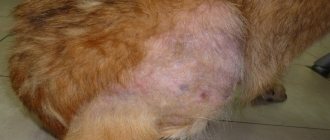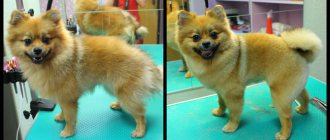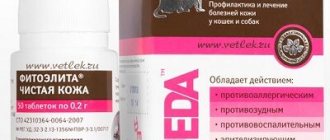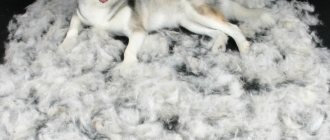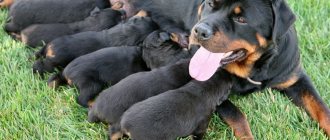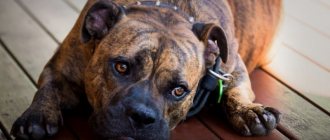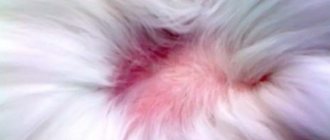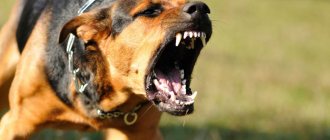Why does a dog's tail go bald?
- The cause of tail baldness is pathology of the sebaceous glands on the pet’s skin. The glands secrete sebum, which nourishes the dog's skin and coat. If sebum is secreted and lubricates the skin and coat, the hair grows smooth and elastic. Sebum plays a protective role. If the sebaceous glands of the skin begin to synthesize an excessive amount of secretion, this can lead to baldness of the tail. Veterinarians call the disorder a mangy tail. In some cases, the disease disappears spontaneously, but more often a secondary infection occurs, promoting the inflammatory process.
- Hair loss of the tail is caused by helminthiasis; fleas become carriers of the disease.
- Endocrinopathies in pets lead to the formation of bald spots on the fur. They can also be caused by excessive adherence to antibiotics.
- The cause of bald spots is lichen, fungal infections, eczema, dermatitis, including allergic ones.
- Lack or excess of vitamins is reflected in the animal’s coat.
Diagnostics
First of all, the veterinarian will perform an external examination of the dog and take an anamnesis. Next, the doctor will choose one of the diagnostic methods to detect alopecia in a pet:
- Biopsy;
- Phototrichogram;
- Glow with an ultraviolet lamp;
- Biochemical, mycological and bacteriological studies of skin scrapings;
- General analysis of blood, urine and feces.
Read Best Flea Treatments for 1, 2 or 3 Months Old Puppies
An ultrasound may be prescribed to examine the functioning of the thyroid gland. The activity of B- and T-lymphocytes in the blood, the content of antigens and protein are being studied.
Treatment of inflammation of the sebaceous glands
Treatment of sebaceous tail begins as early as possible. It is better as prescribed by a doctor and under his supervision.
First of all, you should carefully examine the affected area on your pet’s tail and remove dry caked crusts on the skin, if any. The inflamed area will need to be treated with hydrogen peroxide, then thoroughly dried with a sterile gauze swab. Sprinkle with antiseptic powder on top or apply an ointment bandage with antibiotics.
The inflamed area must be bandaged with a plaster or bandage based on wood glue. Changing the bandage and treating skin wounds is required once a week. The dog will try to remove the bandage or lick ointment and antiseptic solutions from the skin. To prevent eating the medicine, the dog will have to be muzzled for some time or put on a special collar. The bandage on the sore spot is not made too tight. It will take a long time to treat ulcers on a dog’s tail. In parallel, it will be necessary to increase immunity with the help of special drugs.
Prevention of sebaceous gland disease involves constantly removing excess fat from the skin and disinfecting it. It is possible to remove excess sebum using specialized dog shampoos. Look for salicylic acid and birch tar in the composition. It is acceptable to wipe problem areas of your dog’s skin with alcohol.
Dog going bald due to allergies
Your pet may be allergic to components of even high-quality, expensive food. In addition to the bald patches, the dog experiences severe itching. She scratches her body, thereby causing hair loss.
In dogs, allergies are usually of a food nature, sometimes developing to medications, dust, pollen, and chemicals. In addition to itching and hair loss, you will notice redness of the skin and rashes, which usually appear on the stomach, back, armpits, and between the fingers.
Treatment of parasitic infestations
Skin lesions near the tail are often caused by helminthiasis. Skin parasites - lice, fleas, ticks - become carriers of helminth eggs. To remove parasites from an animal, step-by-step complex treatment will be required. First, the animal's fur is treated with special preparations that have a detrimental effect on parasites. This contributes to the death of living pathogens, but the difficulty lies in the laid eggs. Eggs can survive for a long time on the pet’s bedding and belongings, and on surfaces with which the dog often comes into contact. As a result, skin parasites will multiply again, again leading to pathology of the hair in the tail area. It will be necessary to carry out several courses of treatment, constantly monitor the condition of the dog’s skin, and carry out timely prevention or treatment.
In addition to removing skin parasites, the dog is given a course of deworming. Perform at home, after consulting a doctor regarding medications.
Dog treatment
Therapeutic measures for the treatment of bald spots in dogs are largely determined by the causes of their occurrence. During natural shedding, the owner should pay close attention to caring for the pet's coat.
The dog should be combed regularly, using both regular combs and professional furminators. Water procedures are indicated only on the recommendation of a veterinary specialist. To wash your pet, you must use only special animal care products in accordance with the type of coat.
If the main factor in baldness is an unbalanced diet, then the owner’s main task is to adjust the diet. In such a situation, veterinary specialists recommend gradually switching the dog to specialized premium and super-premium medicinal food. Ready-made mixtures contain all the nutrients an animal needs in the correct ratio.
When feeding a dog with natural products, the owner needs to diversify the diet with vegetables, fruits, and seafood, which are sources of vitamins and minerals. The bulk of the diet should be lean beef. Dogs' diet should include lactic acid products - cottage cheese, fermented baked milk, kefir.
On the recommendation of a veterinarian, the dog is prescribed multivitamin complexes and biological supplements. Good results are achieved when using preparations with biotin and brewer's yeast.
In the event that baldness is associated with an allergic reaction, a veterinarian, as a rule, prescribes antihistamines - Suprastin, Tavegil, Loratadine and others. The animal must be switched to hypoallergenic food. Feeding a dog with premium and super-premium class holistic food often has a good therapeutic effect.
Hypoallergenic food
Baldness of a pet due to ringworm requires the owner to strictly follow the recommendations of a veterinarian. The dog is prescribed local antifungal drugs (shampoos, ointments, creams); in advanced cases, systemic antifungal agents are used. For pustular skin lesions accompanied by alopecia, the sick animal is prescribed broad-spectrum antibacterial agents.
If the cause of hair loss is parasitic mites, the veterinarian will prescribe specific acaricidal drugs. In case of helminthic infestation, therapeutic deworming is carried out with general-action drugs - Stronghold, Advocate, Trontsil, etc.
The fight against baldness in a four-legged pet requires increasing the body's immune forces. For this purpose, the animal is prescribed a course of immunomodulators - Gamavit, Anandin, Roncoleukin, Fosprenil, etc.
Classification of causes of alopecia and treatment of symptoms
To understand what problem you are faced with, you should distinguish and combine the accompanying symptoms. The nature of the symptoms determines the clinical picture of the causes.
The diagnosis is made based on symptoms.
Demodicosis
The pathology is caused by the presence of mites of the genus Demodex
.
Animals with reduced resistance properties of the body are most susceptible to infection, regardless of breed, age or gender. The seasonality of the disease is observed - spring, summer, early autumn
.
Mite of the genus Demodex.
Clinical signs include hair loss, roughness and flaking of the skin. Hyperemia, itching. Diagnosed by microscopic examination of skin scraping.
Treatment
Therapy involves the use of sulfur preparations and drugs that contain ivermectin and selemectin. The prognosis is favorable and can be completely eliminated.
The drug Ivermectin is used to treat demodicosis.
Drug allergy
All breeds and age categories are susceptible. The pathology is not tied to gender or seasonality. Mostly pets react to the use of antibiotics and sulfonamides.
In addition to alopecia, animals experience severe itching, focal hyperemia, formation of ulcerative wounds and papules
. Sometimes the temperature rises, and...
In case of drug allergies, severe itching is observed.
The diagnosis is made on the basis of anamnesis, medical history, laboratory blood testing using chemical and biochemical analysis. Eliminated by complete refusal of the course of treatment taken at the time the allergy occurs. Exceptions include severe pathologies with possible death.
Erythema
A classic example of focal baldness. Another name for erythema is alopecia aerata.
It occurs as a complication of a common drug allergy or a reaction to toxic waste products of insects.
The dog has erythema.
It manifests itself as an inflammatory process in the eyes. Papules appear near the oral cavity, which spread further - to the ears, groin area, armpits. The formation of an ulcerative lesion is possible.
Treatment and diagnosis
Diagnosis is carried out using information from the animal’s medical history, biopsy, and symptoms. Help consists of eliminating the root cause and stopping taking medications.
Erythema is treated by avoiding medications.
Flea dermatitis
The reaction occurs to the toxic saliva of insects during bites. Severe intoxication occurs. All breeds and age categories are susceptible. Without reference to gender or seasonality.
The dog has flea dermatitis.
The symptoms are characteristic: in addition to an itchy and bald skin surface, there is redness, focal crusting, and significant areas of scabs.
Treatment
The cause is determined by visual inspection and identification of fleas, and skin samples are taken. Sprays and shampoos are used to kill insects. Severe intoxication is eliminated by the introduction of physiological solutions.
Special shampoos are used to treat flea dermatitis.
Folliculitis
It occurs due to inflammation of the hair follicle as a result of the development of a bacterial infection. Dogs that live outside and are dependent on weather conditions are most susceptible.
The dog has folliculitis.
In addition to hair loss, pustules are observed at the very roots, which open up on their own and become covered with dried crusts. Gradually, the lesions grow and a scab forms. The diagnosis is made on the basis of skin scraping, biopsy of pathological material, and microscopic examination.
Antibiotics
Antibiotics are prescribed for a course of one month and antibacterial ointments and solutions. It is recommended to prescribe symptomatic therapy and maintain the general condition of the body.
Food allergies
A reaction to food occurs as a result of monotony of the diet or due to congenital intolerance to this type of food. Congenital intolerance most often manifests itself in young pets, which will continue to be present throughout life. Acquired intolerance can begin at any age.
Food allergies are caused by foods.
The skin is hyperemic, papules and ulcers form. Localization of the reaction is the belly, the inner side of the paws, the outer surface of the ears. Possible manifestation on the neck.
Elimination of causes
The clinical picture is established using information from the medical history and allergy tests. The cause is eliminated by replacing the diet and prescribing antihistamines.
Antihistamines will help eliminate the disease.
Symptoms of pathology
There are no common symptoms for alopecia; each type of baldness is accompanied by its own set of manifestations. For example, itching and redness of the skin at the site of hair loss are characteristic of demodicosis and allergies. With folliculitis, erythema, flea dermatitis or food allergies, papules filled with serous fluid form on the skin. When they open, they form ulcers.
With folliculitis, an abscess forms in the area of the hair follicle, which can transform into a purulent melting of the skin area. These types of alopecia are accompanied by:
- inflammation;
- redness of the skin;
- increased body temperature;
- hair loss;
- violation of the structure and integrity of the skin;
- itching.
Hormonal causes of alopecia usually do not cause symptoms. Skin hyperpigmentation is sometimes observed. For example, alopecia during pregnancy or hypothyroidism begins suddenly and is manifested only by hair loss. The same picture is observed in the presence of a pattern of alopecia in dogs - a hereditary anomaly in which a puppy is born with normal hair, and after a while begins to go bald. Since there are many causes, but there are no characteristic symptoms, the diagnosis can only be determined through differential diagnosis.
The dog is going bald for no apparent reason
A dog sometimes goes bald for no apparent reason. This may occur due to hormonal imbalance, stress or hereditary predisposition.
Hair loss in dogs is caused by Cushing's syndrome, a lack or excess of estrogen, and a lack of thyroid hormone. Stress
If your pet is constantly worried or exposed to stress for a long time, he may experience hair loss. After eliminating the source of stress, the pet’s fur will grow back after some time.
Some dog breeds are prone to hair loss. These include the Chihuahua, Poodle, Miniature Pinscher, and Pomeranian. With baldness caused by hereditary factors, hair falls out on the body and thighs, but remains on the head and paws. At the same time, the dog looks healthy in appearance, does not experience itching, and there is no peeling or redness on the skin.
Causes of pathology
All the variety of causes of alopecia can be reduced to two groups. Alopecia occurs due to the following reasons:
- hormonal;
- non-hormonal.
These groups have their own characteristic features - with hormonal dysfunction, the formation of symmetrically located lesions is noted. With the non-hormonal nature of baldness, the foci are located chaotically. An allergic reaction to the administration of drugs or at the site of introduction of an infectious agent manifests itself in the form of a single focus. Non-hormonal causes of baldness in dogs include:
Allergies are common in dogs. It may wilt when changing food or introducing certain medications. Often an allergic reaction is accompanied by a severe flea infestation (flea dermatitis). There are also seasonal factors in the development of allergic dermatitis and, as a consequence, alopecia. For example, hair loss can be a reaction to pollen.
Fungal infections often occur in dogs with deep skin folds. So, in Shar-Peis and English bulldogs, the cause of hair loss under the arms, in the folds of the skin, on the back of the ear is a yeast fungus that appears in highly hydrated places.
Hair loss is also observed with acanthosis nigricans, a pigmentary papillary dystrophy of the skin. Another type of keratosis, a compressed callus, is also a cause of baldness in dogs. Hormonal reasons include:
- excess cortisol (Cushing's syndrome);
- growth hormone imbalance;
- excess or lack of estrogen;
- insufficiency of thyroid hormones (hypothyroidism).
Natural causes of hair loss include:
- seasonal shedding, and in some breeds it occurs so profusely that “bald spots” all over the body become noticeable (Pomeranian Spitz);
- hormone imbalance during pregnancy and after childbirth or during estrus;
- stress.
Depending on the reasons that caused hair loss in a dog, the symptoms vary greatly, making it difficult to diagnose the pathology. There is a so-called alopecia X - an idiopathic pathology in which the causes of baldness cannot be identified. Separately, focal alopecia is distinguished, accompanied by complete hair loss in a clearly limited area. The causes of alopecia areata have not yet been identified. But it is suspected that the anomaly is caused by a cellular and humoral reaction to the follicular antigen.
